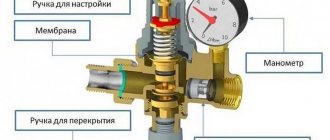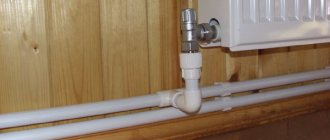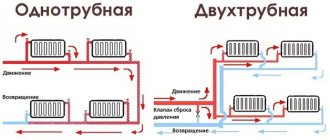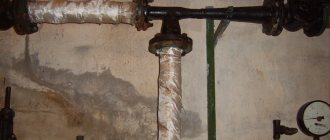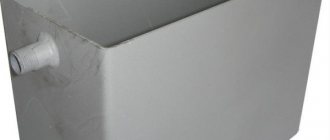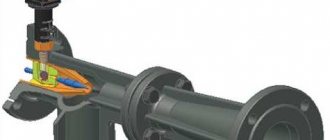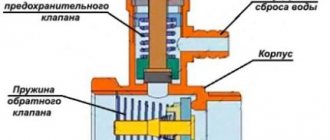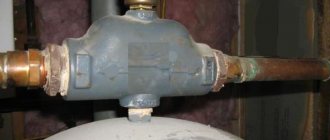An efficient modern heating system is not only a functional boiler, high-quality pipes and high-quality radiators. To ensure uninterrupted operation of this utility network, a number of auxiliary elements are also required: sensors, controllers, relays. Among other things, a heating system make-up must be installed - a unit responsible for the recommended pressure and constant volume of coolant in it.
- 2 Operating principle and types of node control
- 3 Top up an open heating system
- 4 Subtleties of recharging a closed heating circuit
- 5 Example of an automatic make-up system
- 6 Current advice on configuration and maintenance
Why is a check valve needed?
During operation, hydraulic pressure appears inside the heating system, which may be different in different areas.
The reasons for this phenomenon are very different. Most often, this is uneven cooling of the coolant, errors in the design and assembly of the system, or its breakthrough. The result is always the same: the direction of the main fluid flow changes and it turns in the opposite direction.
This is fraught with very serious consequences, including the failure of the boiler, or even the entire system, which will require significant repair costs in the future.
For this reason, experts strongly recommend installing a check valve. The device is capable of passing liquid in only one direction. When reverse flow occurs, the locking mechanism is activated and the hole becomes impassable for the coolant.
Thus, the device is able to control the flow of liquid, passing it in only one direction.
The principle of operation of the check valve is very simple. It passes the coolant fluid in a given direction and blocks the path when it tries to move in the opposite direction
For normal operation of the system, it is necessary that the device does not create additional pressure and freely passes the coolant moving to the radiators
Therefore, it is extremely important to choose the right product
Installation
Installation of make-up is possible after performing the following steps:
- Find a place in the harness with the least pressure. Typically this point is located near the pump unit.
- To prevent mixing of liquids, additional fittings are purchased.
- To protect against overfilling, purchase a second pump.
When choosing a device, you should focus on the size of the building. For small apartments or houses, a simple make-up with supply or return with a small adhesion coefficient is sufficient. Such devices are protected from scale, which increases their service life.
The installation looks like this:
- A valve is placed at the point of minimum pressure of the piping.
- For mechanical systems, a faucet is used that is placed between the cold water supply and heating.
- After testing, a booster pump is installed if the discharge is found to be higher than normal.
- To protect the make-up from water, shut-off valves are installed.
- Connect the pressure gauge.
Final recommendations
When choosing a heating system recharge, be guided by its reliability and ease of use. If you have a small house or apartment, then a simple design is enough. It is recommended to select an actuator with a minimum adhesion coefficient. This material is resistant to the formation of limescale, which means it will last longer.
You can clean the shut-off valve cartridge by following these instructions:
- Isolate make-up equipment.
- Unscrew the control knob at the bottom of the valve.
- Remove the cover by unscrewing the adjusting screw.
- Use pliers to replace the cartridge.
- Put the device back together.
Having installed the recharge, carry out timely repairs of its parts and then the house will always be warm.
Operating principle of the automatic refill valve
The principle of operation, as well as the installation process, of such a device is extremely simple. All operating parameters must be configured in advance. Pre-program future water losses - as a rule, you should additionally indicate the minimum pressure in the network. And if the volume of working fluid decreases, for example, by 10 percent, this will activate the valve, which, in turn, will start the pump.
Using this pump, cold water from the supply pipeline is pumped into the heating main in the required volumes. And as soon as the fluid losses are replenished, the valve will operate again and stop the automatic supply of coolant.
It is quite possible to handle the installation of the described device alone. First, you need to install a pressure gauge or any other electronic contact-type sensor on the pipeline supplying cold water (with the help of such a sensor, the user will be able to regulate the pressure simultaneously in two directions). One of the groups must be set to the minimum pressure in the network.
It is in this place that a contactor or intermediate relay should be installed. And as soon as the volume of hot coolant in the closed line decreases, this contactor initiates the activation of a mechanism that will start the extraction pumping equipment. There is a second group - it is necessary in order to deactivate all these processes when fluid losses are replenished. The actuating element in this case can be an electric valve - a kind of valve equipped with an electric motor.
Important note! If the heating system is recharged using automation, then it (the automation) will independently both control the operating pressure and calculate the compensation volume of liquid. Bypass make-up - when might it be required?
Bypass make-up - when might it be required?
It just so happens that almost all closed-type heating systems are capable of functioning normally only at high pressure of the working fluid. Although this is not the only important factor, since the temperature of the coolant also takes place.
So, if the temperature rises, this leads to thermal expansion of individual technical network nodes. And in order to compensate for this expansion, a special hydraulic accumulator (also known as an expamzomat) is installed, which is capable of absorbing excess hydraulic energy or, conversely, releasing it in case of deficiency. The hydraulic accumulator is connected in the same way as a plumbing bypass.
Feeding open type systems: diagrams, instructions
A distinctive feature of an open heating line is that there is no high pressure in it. In this regard, an expansion tank, albeit a somewhat modernized one, can serve as a kind of sensor for reducing the volume of liquid. This tank should be installed at the highest point of the system.
Note! In this case, replenishment will be carried out exclusively when the volume of coolant in the tank decreases. To find out whether the level has really dropped, you need to open the control pipe: if there is a shortage of coolant, there will be no pressure there
Often the outlet of this pipe is installed in the kitchen or bathroom. And if there is no pressure during the inspection, it means that working fluid needs to be added to the system. For this purpose, another element of the feeding system is used - a node that connects the heating network to the water supply. From a constructive point of view, this unit will include such elements.
- A ball valve that closes/opens the flow of water into the network.
- Non-return valve - it is needed to prevent the backflow of liquid from the network into the water supply. This can happen, for example, if there is no water in the centralized water supply pipeline.
- Filter. As you know, the quality of tap water does not always meet the requirements, so it must be additionally purified from various types of debris. If this is not done, a layer of scale will form on the internal surfaces of the metal elements.
It is according to this scheme that an open-type heating system is recharged. But it is worth remembering that you need to install an air vent in advance, with the help of which excess air will be removed. Let us also add that in order to properly replenish the volume of water, its minimum temperature is needed.
Note! A simpler recharge scheme may consist of an ordinary storage tank, although the water level in this case must be monitored visually
Make-up device for heating system
Actuating mechanism
If replenishment is carried out mechanically, then all manipulations are carried out using one valve. Automatic units use various types of remotely controlled valves. But in most cases, a pressure reducing valve for automatically recharging the heating system is used. Typically this is a combination device that includes a shut-off valve, a check valve and a pressure reducer. It can be mechanical or have electrical contacts to control the pump.
The device is adjusted to the required operating pressure range. When the lower coolant pressure threshold is reached (say, 5 or 10 percent), the membrane releases a spring, which moves the working rod with a cone that closes the flow hole of the valve. After pumping the system to the required pressure level, the membrane compresses the spring and closes the flow with a rod.
Pressure reducing valve device for automatic replenishment
The valve response pressure is adjusted using a screw located on top of the device. Once installed in the desired position, it is secured with a lock nut. To visually monitor the pressure during adjustment, the valve is equipped with a pressure gauge.
Check valve
Under no circumstances should hot water from the heating system enter cold water supply pipes. Firstly, it can lead to the development of bacteria in drinking water. Secondly, waste coolant can be quite harmful to humans, since corrosion products accumulate in it. Thirdly, this way we lose coolant, which again negatively affects the operation of the heating installation. Reverse movement of the coolant can occur during replenishment if the pressure in the supply line is insufficient (in the water supply it is lower than in the heating system), or during operation if the shut-off valve “does not hold.”
The check valve is always installed at the rear of the actuator and is often built into the pressure reducing valve body. Recently, the make-up unit is also equipped with a check valve at the front or a so-called “flow breaker” is used.
Pump and accumulator
The main task of the pump is to increase the pressure in the supply pipeline, for example, when the pressure in the cold water supply pipes is lower than in the heating system. Therefore, it will not be possible to add water to the heating either manually or automatically. And if the check valve is absent or malfunctioning, there will also be an additional loss of coolant.
Floor-mounted make-up unit with vertical pump
A storage tank connected to the make-up unit allows you to always have a supply of water with which you can replenish the system, regardless of the pressure level in the drinking pipeline. To manually replenish the coolant in gravity circuits, a container is used that is located above the expansion tank, that is, somewhere in the attic. Automatic recharge systems often use a hydraulic accumulator with a membrane, which is always under pressure.
Filter elements
Impurities found in water can negatively affect the operation of heating and even damage heating appliances and devices. It is best to filter and prepare water immediately at the “inlet”. For mechanical cleaning of the coolant, mesh filters are used, which are mounted upstream of the pressure reducing valve. Sometimes mud collectors are an integral part of the actuator. To soften water (mainly to combat calcium salts), filters are used that bind and precipitate “unnecessary” substances using chemical reagents.
Automatic make-up is located on the bypass
Popular ball models
A number of devices that use a metal ball to seal the liquid and have a low cost.
Tim JH-1014
Characteristics:
- body and locking structure material – brass;
- maximum temperature – 130 °C;
- connection type – coupling (BP/BP);
- price – 660 rub.
Valve for use in the installation of hot and cold water supply, heating, transmission of compressed air, gases and liquids that do not interact with the product material. The model has no rubbing surfaces and can be mounted in any position without changing characteristics.
The spherical chamber increases throughput compared to cylindrical counterparts. The operating pressure of the valve is from 0.05 bar.
1″ ALTSTREAM
Characteristics:
- thread type – 1″;
- temperature range – from -20 °C to 150 °C;
- tightness of the locking element - class A;
- material – brass;
- type of flow – full bore;
- price – 400 rub.
The ball design is used to lock pipeline systems for household and drinking purposes, heating, hot water supply, and compressed air. The product has a service life of 30 years and can be repaired. The minimum production resource is 25 thousand cycles.
How to connect to the heating system
With a closed circuit, there is not much difference where to connect the make-up pipeline - to the supply or return. We recommend using the classic proven method - the insertion point should be located on the return line next to the boiler, after the circulation pump and expansion tank. Causes:
- the unit is located in the combustion room, next to the equipment and instruments;
- pumping water into the return line is immediately reflected on the pressure gauge installed in the supply behind the boiler;
- the insert is located at the lowest point, the flow is distributed in 2 directions - into the boiler and radiators, the air is squeezed out evenly.
Classic scheme for inserting a recharge module
In a similar way, the make-up flows into the return line of the open system. The second option is to add coolant directly to the tank; the disadvantage of this method is to lay the supply pipe into the attic.
The correct connection is shown on the left - inside the primary boiler circuit
Connecting the make-up line is also allowed at other points:
- to a separate fitting of a solid fuel boiler, provided by the manufacturer;
- to the bottom of the hydraulic arrow;
- to the return manifold of the distribution comb;
- to the outlet of the indirect heating boiler.
These options are usually implemented in complex and extensive systems of country cottages. Connecting the make-up to the boiler is demonstrated in the next video:
What it is?
It is impossible to organize continuous heating of water using conventional methods, so a simple and effective method is used - the hot water supply line is looped and the circulation process is started.
The flow leaves the boiler, passes in a circle and returns to the heating container.
All that remains is to adjust the speed of movement to ensure the supply of water at the standard temperature for all subscribers of the line.
How to choose equipment
One of the important points is the selection of a heat source based on power and type of energy carrier used:
- on natural or liquefied gas;
- on solid fuel - wood, coal, pellets;
- on electricity;
- on liquid fuel - diesel fuel, waste oil.
The power of the boiler installation is calculated in the standard way: the heated area of the home is multiplied by 0.1 to convert to kilowatts and by a safety factor of 1.3. That is, for a house of 100 m² you need a heat source with a power of 100 x 0.1 x 1.3 = 13 kW.
For a closed heating system, it does not matter which heat generator you buy, so we will not consider this issue in detail. But you will make your task much easier if you purchase a wall-mounted gas boiler equipped with its own circulation pump and expansion tank, as shown in the photo. For a small house, all that remains is to select pipes and heating devices, which will be discussed further.
Types of pipes
The heating network of a private house can be installed from the following pipes:
- PPR (polypropylene);
- cross-linked polyethylene – PEX, PE-RT;
- metal-plastic;
- metal options: copper, steel and corrugated stainless steel.
For self-installation at low financial costs, it is better to take polymer pipes. To assemble crimp connections from metal-plastic and polyethylene, you do not need special tools, but polypropylene will have to be soldered (a welding machine is rented). Of course, PPR material has no equal in cost, but for reasons of reliability and durability, we recommend using PEX pipelines made of cross-linked polyethylene.
Copper and corrugated stainless steel can also be mounted on compression fittings, but the first has a high price, and the second has significant hydraulic resistance. As for ferrous metal, it is inconvenient in all respects - welding installation and susceptibility to corrosion relegate it to last place. More details about the choice of pipes are described in the next video:
Which radiators are better
The following types of heating devices are currently offered in the retail chain:
- steel panels;
- made from an alloy of aluminum and silicon (silumin);
- the same, but with a frame made of steel pipes, name - bimetallic;
- cast iron batteries are analogues of the Soviet “accordion” MC 140 and retro-style models.
Steel panel radiator
From the point of view of economy, it is more profitable to buy steel batteries, which have an affordable price. Aluminum appliances are more expensive, but give off heat more intensely. These 2 varieties are most in demand for closed heating systems in private houses.
Aluminum heating device
Bimetallic radiators are designed for heating networks with low-quality coolant supplied with pressure drops, which is typical for centralized heating supply of apartment buildings. It makes no sense to buy these expensive products for a country house with autonomous heating.
To select a heating device based on power, make a simple calculation: divide the heat transfer indicated in the passport by 1.5. This way you will find out the real power of the radiator, because the documentation reflects characteristics for certain operating conditions that do not coincide with reality.
Pump and expansion tank
In closed heating systems of private homes, 3 types of household circulation pumps are usually used, developing a pressure of 4, 6 and 8 m of water column (this is a pressure of 0.4, 0.6 and 0.8 bar, respectively). We suggest that you do not delve into complex hydraulic calculations, but select a pumping unit based on the following characteristics:
- For one- and two-story buildings with an area of up to 200 m², a pressure of 4 m is sufficient.
- A cottage with an area of 200-300 m² will need a pump with a pressure of 0.6 Bar (6 m).
- Circulation in the network of a three-story mansion of 400-500 m² will be provided by a unit with a pressure of 8 m of water column.
To select the size of the expansion tank, you should calculate the volume of water in the entire closed heating system along with the boiler tank. Considering the fact that when heated from 10 to 90 °C, water expands by approximately 5%, the capacity of the tank should be 1/10 of the total amount of coolant.
Subtleties of recharging a closed heating circuit
For a closed heating system, the best solution is to install an automatic make-up unit. If the pressure drops below the minimum level, the installation itself solves the “problem”. Various types of fittings can be used in automatic units, but it is best to choose a gearbox with a built-in filter, a check valve and a valve equipped with a pressure gauge. The pressure gauge is used to visually monitor the pressure indicator.
For schemes that involve the addition of tap water, it would be a good idea to install a full-fledged device for comprehensive filtration of liquid from impurities
It is optimal to install the make-up device on the bypass. Having packed all the threaded connections and soldered the mounting taps (for dismantling, replacing or repairing fittings), the assembled unit can be connected to the selected point of the heating system. To start the installation, it must be set to the desired operating pressure. This manipulation is carried out using the adjustment screw located at the top of the device. By smoothly tightening and monitoring the indicators on the pressure gauge, you need to set the required parameter value. Then secure the screw with a locknut.
Operating principle and types of node control
The most important task of the make-up unit is the ability to supplement the missing part of the coolant into the heating system, which will normalize the operating pressure.
Today, there are a couple of options for replenishing the volume of lost thermal fluid:
- Manual control is most convenient when servicing a small heating system, in which it is possible to independently control the pressure level in strict accordance with the pressure gauge. In this case, the supply of coolant occurs by gravity or using make-up pumping equipment.
- The automatic make-up mode automatically turns on when the pressure level inside the system drops below the established limits. In this case, the valve is activated to replenish the heating system and the flow hole is opened with a forced supply of coolant. After equalizing the pressure indicators, the valve closes, and the standard shutdown of the pumping equipment is performed.
Despite the convenience of the second option, it is very important to remember that the automatic recharge mode requires the mandatory inclusion of an additional element in the system that requires electrical supply. In case of frequent power outages, it is advisable to duplicate the automatic control of the manual recharge lever
Autofill device configuration
Before turning on the installation, you need to configure it and indicate the pressure required for operation
If you pay attention to the top of the device, you will find a special screw there, which is designed to adjust the working pressure. Unscrew the screw until it stops and begin to tighten it back slowly, looking at the pressure gauge. When the pressure reaches the level you require, secure it with a lock nut
The lever, which is located at the bottom of the shut-off device, is rarely used, because it is only needed to release fluid into the circuit. This can be done by unscrewing the screw and, accordingly, blocking its output by tightening
When the pressure reaches the level you require, secure it with a lock nut. The lever, which is located at the bottom of the shut-off device, is rarely used, because it is only needed to release fluid into the circuit. This can be done by unscrewing the screw and, accordingly, blocking its output by tightening it.
Take a look around again and make sure that the device is configured correctly and all components are in working order.
Current advice on configuration and maintenance
Whatever power supply you choose, remember, first of all, it should be safe and easy to use, made of high-quality materials. If the heating system is small, give preference to a device with the simplest possible design. The central support with moving parts and the internal compensation piston must be made of materials with a low adhesion coefficient: the risk of lime formation in the unit must be minimized. It is no secret that they are the main reason for the poor performance of the device.
Please note whether the product has a replaceable cartridge: this will greatly facilitate and speed up the process of inspecting the unit for you. Periodic maintenance of the make-up device will help avoid malfunctions in the entire heating system.
Periodic maintenance of the make-up device will help avoid malfunctions in the entire heating system.
To clean or replace the entire cartridge, proceed as follows:
- Insulate the installation.
- Unscrew the control knob located at the bottom.
- Unscrew the adjustment screw until it stops and remove the cover.
- Remove the cartridge with pliers.
- After the necessary manipulations, reassemble the device.
All that remains is to set up the equipment again and continue to enjoy the uninterrupted operation of the heating system in your home!
(1 vote, average: 5 out of 5)
Replacing water with antifreeze
If the system has already used water, and you want to switch to antifreeze, then two circumstances should be taken into account.
Secondly
. It is never possible to completely remove water from the heating system. Some of the water remains. If you simply pour prepared diluted antifreeze, its concentration will be insufficient for reliable protection against freezing. Thus, a concentrate must be used. I usually mix concentrate with diluted antifreeze in a 1:1 ratio. After filling the system, you need to start the circulation pump (for a system with forced circulation) or turn on the boiler (for a system with natural circulation) so that the coolant is thoroughly mixed. Then you need to pour out some coolant and measure its density. There is a device for measuring density that is sold in most car dealerships. This device is used to prepare a car for winter (checking the properties of antifreeze in the engine cooling system), but it is also perfect for our purposes. If the device shows a freezing temperature lower than necessary, for example -50 degrees, it’s okay, but if the temperature is higher than we need, then we will have to drain part of the coolant and replace it with concentrate. The drained coolant must be disposed of carefully; it is poisonous and should not be poured into septic tanks or ditches.
I would also like to draw your attention to the fact that different antifreezes may be incompatible with each other. There is an opinion that red composition should not be mixed with a composition of another color. This is true, but in fact there are other undesirable combinations
Supplements from different brands may react with each other or simply reduce each other's effectiveness. Unfortunately, manufacturers do not indicate what other antifreezes their product can be mixed with. My advice is to pick one brand and stick with it. If you still need to mix, then mix liquids of the same color and before pouring, pour a little coolant from the heating system, mix it in a jar with a new composition and see if a sediment forms, if the liquid becomes cloudy, or if it loses its homogeneity
This is true, but in fact there are other undesirable combinations. Supplements from different brands may react with each other or simply reduce each other's effectiveness. Unfortunately, manufacturers do not indicate what other antifreezes their product can be mixed with. My advice is to pick one brand and stick with it. If you still need to mix, then mix liquids of the same color and before pouring, pour out a little coolant from the heating system, mix it in a jar with a new composition and see if a sediment forms, if the liquid becomes cloudy, or loses its homogeneity.
Filling closed heating with a pump
If the circuit is not connected to the water supply, the only option left to fill the heating system is a pressure test pump. This is a small rectangular metal reservoir into which liquid is collected. From the reservoir, the coolant is supplied to the pipes thanks to a pump-action hand pump on which a pressure gauge is installed.
Hand pump for pressure testing.
There is nothing complicated about how to fill a closed heating system. Work algorithm:
- connect the hose from the pump to the circuit;
- pour coolant into the pump reservoir;
- manually pump fluid into the system.
If there is no pipe for draining water from the circuit, then you can connect the pump hose to one of the ends of the battery. To do this, you need to unscrew the plug and put the adapter in its place. Before starting work, be sure to open all air vents so that air can leave the circuit.
When working with thermal insulation in sheets and rolls, you need to use an insulation dowel or nail to fix the material.
Watch the pressure gauge reading carefully. Using such a pump, pressure testing of the heating system is carried out. They can pump up pressure to 10 atmospheres (if you have enough strength). When filling the system, such pressure is not necessary, otherwise the boiler will break.
When is it necessary?
The need for circulation arises in long lines with a large number of subscribers, for example, in apartment buildings or public buildings. In a dead-end pipeline, the water will quickly cool down.
This phenomenon is pronounced at night, when water intake practically stops and the water loses thermal energy.
Starting circulation allows you to:
- constantly update the flow in the pipes,
- heat cooled water to ensure standard values.
In small water supply systems of one-story private houses, circulation is rarely used. The distance from the water heater to the water collection points is relatively small, so it is not advisable to spend money on purchasing or installing a pump, assembling a loop, and starting the process.
It’s easier to let a little water through, which has had time to cool down, to get a normal hot stream.
In what places should I install it?
The make-up valve, as well as the other technological components of the system, should be installed only in a strictly designated place. Let's look at the basic requirements for installing this device.
SNiP standards and recommendations for installation of heating systems
Previously, we talked about what SNiP standards and recommendations should be followed when installing heating systems; in addition to this article, we advise you to read this information; see all the details here
- All feed valves must be equipped with pressure gauges!
- The heating system recharge, or more precisely, the valve itself, must be installed in that part of the network where the pressure of the working fluid is minimal. If we talk about closed-type systems, then in them such a place is precisely the entrance next to the pumping equipment.
- To prevent water from the network from entering the make-up line, it is also recommended to additionally install a shut-off valve.
- If a valve with mechanical control is installed, then the installation of a valve or tap is also required. They need to be installed between the cold water supply line and the heating circuit itself.
- If the circulation pump reaches a pressure higher than the pressure created by the make-up valve, it is also necessary to install a booster pump.
For a more detailed introduction to the process, we recommend watching the thematic video material.
Video - Topping up the heating system
Types of recharge: mechanical and automatic
There are two ways to control the recharge device:
- mechanical;
- auto.
Control method No. 1 is appropriate where small heating systems are used. In this kind of lines, all pressure differences of the working fluid are regulated by means of special membrane tanks. In this case, it is much easier to resume coolant losses by manually opening the tap on the pipeline supplying cold water. This method is extremely simple, but is associated with certain inconveniences: to perform such seemingly simple manipulations, experience is required, in addition, appropriate technical skills and knowledge are needed.
Note! If a mechanical valve is used, you will have to control the intra-system pressure in a closed-loop network yourself. And if the volume of working fluid increases too much, this is fraught with emergency situations
But automatic replenishment of the heating system is used in large highways with significant branches. Sometimes they are equipped with heating boilers, which also become elements of their systems. Installing such valves does not cause any difficulties, since it can be done with your own hands. Although there is one “but”: after installing an automatic valve, the entire heating network will become volatile
And you should definitely pay attention to this when choosing this or that type of feeding unit
You can learn more about the technical parameters of the valves, as well as their average market value, from the table below.
Table. Comparative characteristics of popular feed valves
| Name | Material | Type | Diameter, cm | Limit temperature | Adjustment range | Price |
| Honeywell VF04 1/2 E | Brass | Mechanics | 1,5 | 70 degrees | Up to 6 bar | 2600 rubles |
| ISMA 1/2 | Brass | Mechanics | 1,5 | 90 degrees | Up to 4 bar | 1350 rubles |
| Meibes Fuelly 1/2 | Brass | Automation | 1,5 | – | 0.43 bar | 1710 rubles |
| Tiemme 1 | Brass + plastic | Automation | 3 | – | Up to 1.5 bar | 3680 rubles |
| Caleffi 1/2 | Brass + plastic | Automation | 1,5 | 65 degrees | Up to 4 bar | 3520 rubles |
| Watts Alimat Alomd 1/2 | Brass + plastic | Automation | 1,5 | – | Up to 4 bar | 3750 rubles |
This is interesting: Heat accumulator for heating boilers - design, types, installation rules
About connecting the make-up
The ideal place to create a recharge unit is an area with minimal pressure, preferably at the lowest point. Make-up is done on the return line, however, so that too cold water does not enter the heat generator (this is not very good for the heat exchanger of a working boiler), the pressure reducing valve is somewhat removed from the boiler or even placed on the DHW pipe if the heating device is double-circuit. In order to be able to service/repair the automatic make-up unit and not turn off the heating during this time, it is connected using a bypass and shut-off valves.

